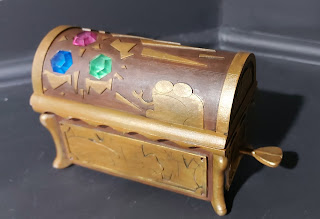In chemistry terms, a resin is a solid or highly viscous substance of plant or synthetic origin that is typically convertible into polymers (a polymer is a synthetic material like nylon, polyethylene, polyester, Teflon, and epoxy).
In terms relating to miniature and model painting, resin printing is a type of 3D printing used to create highly-detailed models, exactly the kind that can be used for said painting. The process beams ultraviolet (UV) light into a tank of liquid resin, triggering a reaction that solidifies the resin into a hard plastic. The individual layers of printing can be as thin as 0.02mm, so you get some VERY precise details with this type of printer. Dentists even use them for creating crowns and false teeth!
The great thing about 3D printing is creating your own models in whatever size and shape you desire. You can find or buy countless model files online, and if you have the talent and skills you can also create your own. It’s also very cost-effective. Good quality miniatures can easily run $5-$15 each (or more, for Warhammer minis), whereas the material of cost of said minis on a resin printer is often just pennies.
(And yes, I acknowledge that the purchase and maintenance of the printer is not negligible, however in the long run it more than pays for itself).
A couple of things to be aware of: UV printer resin is not as flexible as most other types of plastic. It can be brittle, so dropping it, especially tiny people with itty-bitty arms and sword and stuff, can be VERY catastrophic. You can mitigate this by using certain types of tough (and slightly more expensive) resin, which I’ve since switched to, because it’s just too heartbreaking to drop an entire tray of a dozen or more printed, cleaned, prepped and primed minis (representing hours and hours of work) to have them shatter in hundreds of pieces.
Another sticking point is that resin is toxic, and gives off potentially harmful fumes when printing. This resulted in me setting up a complicated series of heaters, fans and HEPA filters in my garage in order to run it, but again, it’s something you just have to plan and work with. I wouldn’t recommend running a resin printer in your bedroom with the doors and windows closed, but most people can get by with an open window and a simple fan.
Anyway, despite the drawbacks, 3D printing is SUPER addictive and gives me a nearly unlimited supply of models to paint. I literally have close to a hundred waiting for me, and I’m still constantly finding more stuff I want to print. If you’re into model painting, I can’t recommend it enough. Or at the very least, find a friend who has a printer. Otherwise you’re going to end up buying prints on Etsy, which, lemme tell you from experience, ends up being WAY more expensive in the long run than buying your own.
Hugs & Kisses,
-CDGK






8 comments:
How do you produce the information to create the figures for your printer or do you have to buy them? I am a CAD draughtsman among other things and I know how to create shapes made up of simple solids, - but figures?
I am particularly pleased with my post today, which took a lot of writing and tackles one of the hot topics of today - Robots and AI...
https://how-would-you-know.com/2023/04/r-robot-robota-czech-for-forced-labour-foreign-words-appropriated-rule-of-thumb.html
My brother could use one of those. I'm sure he'd make all sorts of things with it.
I never knew they were toxic and needed to be used in an open area. I have a barn but wouldn't think I would want to keep a printer there.
There are new programs designed specifically for 3D drafting. Blender and ZBrush are among the most popular currently. It's the same kind of software used by video game designers and movie special effect artists. Then you just need to run it through a second program - a slicer - to convert it into information the printer can read.
I didn't know they were toxic either. One of my cousins has one and prints bigger things which he builds into cabins. I've never seen one in person, but I've seen pictures.
One would have been great for me when I was into dollhouses.
There's another kind of 3d printer that uses melted plastic that's not toxic. It can't make as fine details as resin, but it's cheaper and tougher.
And yes, a 3D printer is AMAZING for making small furniture. 😁
I think I need to stay far away from 3D printers - I have no doubt I'd become an obsessive addict.
We actually kickstarted a resin printer, which has now arrived and is sitting in our overstuffed project room, out of its box but so far unused. We are very excited about it, but need to work out a better exhaust situation than what we have in there so far (which is no exhaust situation, the air will stay there until we all die). That is a good tip about the fragility of resin minis.
Post a Comment